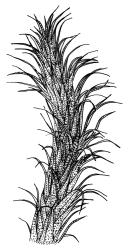Description as per Cyrtopus setosus:
Plants robust, on tree trunks or vertical rock, forming loose tufts that are weakly pendent and curved upward away from the substrate, yellow- or brown-green. Primary stems creeping, sometimes eroded. Secondary stems (stipes), irregularly or subpinnately branched, commonly curving upward from the substrate, dark brown and very stiff, (15–)60–120(–160) mm, in cross-section with little internal differentiation, lacking a central strand. Leaves of secondary stems and branches not differentiated, erect-appressed, somewhat flexuose, and with a few weak to strong longitudinal pleats on each side of the costa when dry, smooth, erect-spreading and sometimes weakly homomallous when moist, abruptly tapered from an oblong-obovate, concave, and non-clasping base to a long, subulate apex, (4–)5–7(–9) × 1.2–1.4 mm; margins sharply and singly toothed by projecting cell-ends and partially bistratose in the subula, entire and unistratose in the base; upper laminal cells (near base of the subula) mostly oblong to rounded-subquadrate, smooth, mostly 12–21 × 6–9 µm (but a few longer and narrower), partially bistratose; interior laminal cells of the leaf base linear, thick-walled, strongly porose, smooth, mostly (60–)75–100 µm long, unistratose; marginal laminal cells of the leaf base rounded-oblate to rounded-subquadrate in c. 12–15 rows that extend to the shoulder, thick-walled, lacking pores, with fine, ± radiate cuticular striations or smooth; extreme basal cells and alar cells not differentiated; costa narrow (c. 60 µm wide near base), percurrent to short excurrent, weakly toothed at back above (the teeth not visible under stereoscope), in cross-section (in leaf base) biconvex, with abaxial and adaxial stereids enclosing a single central layer of guide cells, becoming ± semi-circular in the subula.
Dioicous. Perichaetia scattered on secondary stems and branches, the leaves about half the length of vegetative leaves, with marginal cells less differentiated and costa ± filling the subula. Perigonia rarely seen, gemmiform, scattered on secondary stems, c. 1.5 mm, the inner bracts yellow, ovate-lanceolate, mostly ecostate, surrounding numerous antheridia and yellow filiform paraphyses. Setae straight, smooth, brown, and twisted to the left above, c. 3–4 mm; capsules exserted beyond the perichaetial leaves, erect, symmetric, oblong-cylindric, smooth and little altered when dry, brown at maturity, c. 3 mm; mouth transverse; exothecial cells mostly oblong to ± irregular, firm-walled, not thickened in corners; stomata very few and difficult to see at the extreme capsule base; annulus absent; operculum obliquely rostrate, 1.5–2.0 mm. Peristome double; exostome teeth yellow-brown, linear-lanceolate, c. 580–750 µm, inwardly circinate when dry, with a straight abaxial median line, baculate-spinose below, with robust adaxial lamellae and usually appearing crenulate at margins; endostome segments arising from a very low membrane, straight when dry, nearly the height of the exostome teeth, pale brown, baculate throughout, lacking cilia. Calyptra cucullate, smooth, and naked. Spores round, 9–11 µm diam., smooth.
| Category | Number |
|---|---|
| Indigenous (Non-endemic) | 1 |
| Total | 1 |




